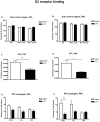Effect of maternal lipopolysaccharide administration on the development of dopaminergic receptors and transporter in the rat offspring
- PMID: 23349891
- PMCID: PMC3547943
- DOI: 10.1371/journal.pone.0054439
Effect of maternal lipopolysaccharide administration on the development of dopaminergic receptors and transporter in the rat offspring
Abstract
Epidemiological evidence supports that maternal infection during gestation are notable risk factors for developmental mental illnesses including schizophrenia and autism. In prenatal lipopolysaccharide (LPS) model of immune activation in rats, the offspring exhibit significant impairments in behaviors mediated by central dopamine (DA) system. This study aimed to examine the temporal and regional pattern of postnatal DA development in the male offspring of pregnant Sprague-Dawley rats administered with 100 µg/kg LPS or saline at gestational days 15/16. Using ligand autoradiography, D1 and D2 dopamine receptors (D1R, D2R) and dopamine transporter (DAT) binding levels were measured in the prefrontal cortex (PFC) and sub cortical regions (dorsal striatum and nucleus accumbens core and shell) at pre pubertal (P35) and post pubertal ages (P60). We found a significant decrease in D2R ligand [(3)H] YM-90151-2 binding in the medial PFC (mPFC) in prenatal LPS-treated animals at P35 and P60 compared to respective saline groups. The decrease in D2R levels was not observed in the striatum or accumbens of maternal LPS-treated animals. No significant changes were observed in [(3)H] SCH23390 binding to D1R. However, the level of [(125)I] RTI-121 binding to DAT was selectively reduced in the nucleus accumbens core and shell at P35 in the prenatal LPS group. Immunohistochemical analysis showed that number of D2R immunopositive cells in infralimbic/prelimbic (IL/PL) part of mPFC was significantly reduced in the LPS group at P60. Prenatal LPS treatment did not significantly affect either the total number of mature neurons or parvalbumin (PV)-immunopositive interneurons in this region. However the number of PV and D2R co-labeled neurons was significantly reduced in the IL/PL subregion of PFC of LPS treated animals. Our data suggests D2R deficit in the PFC and PV interneurons may be relevant to understanding mechanisms of cortical dysfunctions described in prenatal infection animal models as well as schizophrenia.
Conflict of interest statement
Figures







References
-
- Riley B, Kendler KS (2011) Classical genetic studies of schizophrenia. In: Weinberger DR, Harrison PJ, editors. Schizophrenia. Chichester, West Sussex: Wiley-Blackwell. pp 245–268.
-
- van Os J, Kenis G, Rutten BPF (2010) The environment and schizophrenia. Nature 468: 203–212. - PubMed
-
- Atladottir HO, Thorsen P, Ostergaard L, Schendel DE, Lemcke S, et al. (2010) Maternal infection requiring hospitalization during pregnancy and autism spectrum disorders. J Autism Dev Disord 40: 1423–1430. - PubMed
Publication types
MeSH terms
Substances
Grants and funding
LinkOut - more resources
Full Text Sources
Other Literature Sources
Research Materials
Miscellaneous

